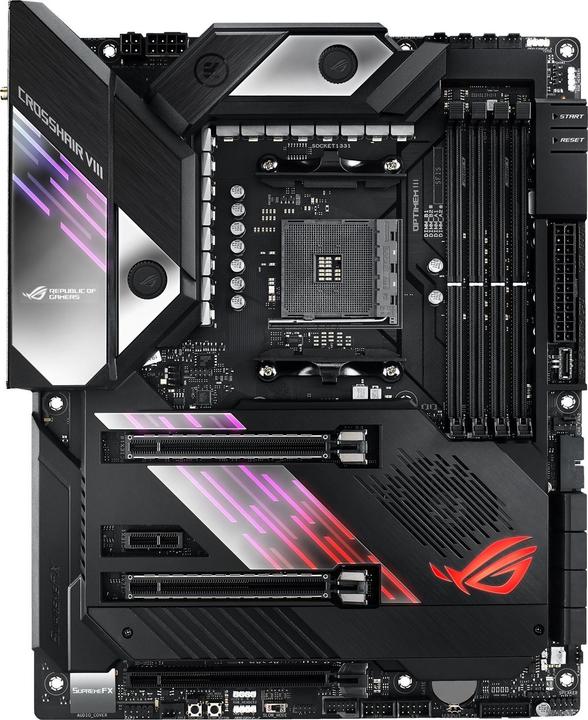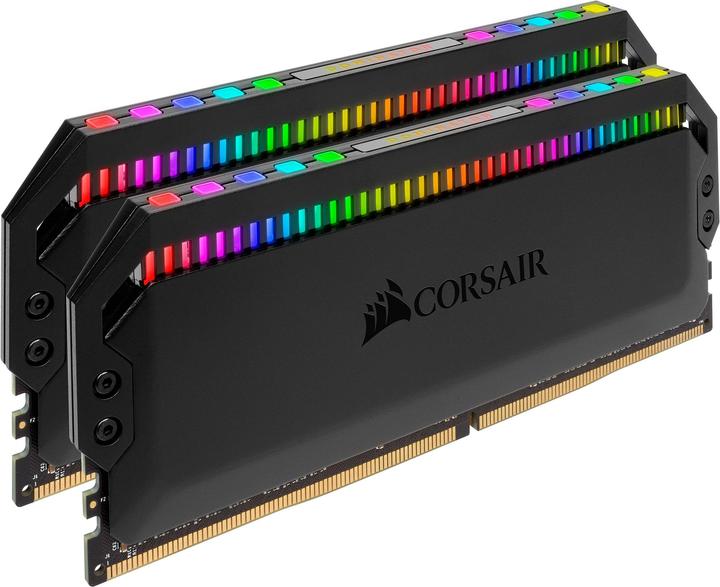

Asus TUF RTX 3080 on test: what the new card is worth
The GeForce RTX 3080 is Nvidia's first true high-end graphics card for two years. It offers up to twice the performance of an RTX 2080 Super, is perfect for 2160p gaming and is a bargain compared to the previous model.
The release of the RTX 3080 ushers in a very interesting period for PC gamers: it marks the start of a series of new graphics cards to be released soon. These include the top-of-the-range RTX 3090 and the RTX 3070 in mid-October. At the end of October, AMD will release the Big Navi. But I'm getting ahead of myself. Today we're going to look at the GeForce RTX 3080. Asus provided me with the TUF RTX 3080 O10G-GAMING for testing. It costs around CHF 740.

The card in detail
Although Ampere has evolved from Turing, which was a mini-revolution, there are still various changes. Nvidia is using Samsung's 8nm process. This allows for greater transistor density and improved energy efficiency. The new continuous multiprocessor (SM) doubles the theoretical maximum processing power of the FP32. This is why the teraflops of the 30 series boards are so high. The RT and Tensor cores have also been upgraded, resulting in improved performance in specific areas. The last two major changes are the move to GDDR6X memory and PCIe 4.0, which significantly increases memory bandwidth and PCIe bandwidth.
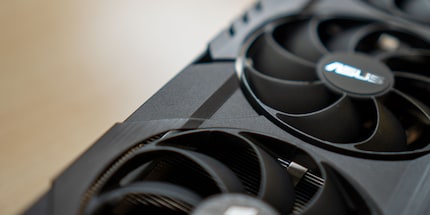
The RTX 3080 uses a lighter version of the GA102 GPU. This monster chip has more than 28 billion transistors in an area of 628.4 square millimetres. Compared with the RTX 2080, it has more of everything: CUDA cores, RT cores, texture units, ROP, cache, memory and memory bandwidth. Tensor cores are the exception, as Ampere halves the number of cores per SM. Each Tensor core operates two to four times faster, depending on the load. In terms of clock frequency, Nvidia is maintaining more or less the same level as the original RTX 2080. Despite the new process, which offers greater energy efficiency, power consumption has increased significantly due to the huge amount of additional transistors and processing blocks: 320W, 105 more than the RTX 2080.
More power obviously also means more heat. Nvidia has equipped the Founders Edition with a special new cooler. The test will show how the TUF performs in its classic design with three axial fans.
When it comes to design, the TUF opts for sobriety. The RGBs are only found on the front in the area of the illuminated TUF logo. Otherwise, the card is grey-black. Asus supplies the card with a back plate bearing the TUF logo. Unlike the Founders Edition, you don't need a 12-pin connector with the TUF. Asus has preferred two standardised 8-pin connectors.
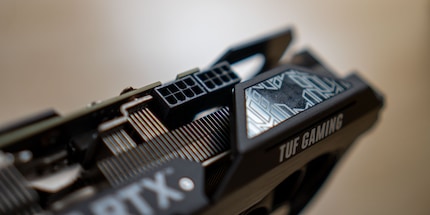
At just 30 centimetres long, the card is no longer than previous top-of-the-range models. It is, however, thicker, with slots 5.17 and 2.7 centimetres thick. You won't be able to fit it into smaller systems.
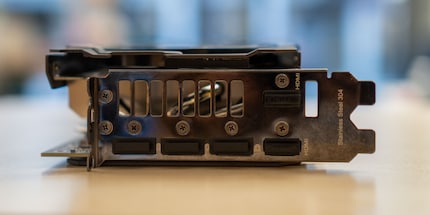
As for connectivity, there are two HDMI 2.1 and three DisplayPort 1.4 connectors. USB C is missing from the list. Asus recommends 750W for the power supply. A good point despite the high power consumption: the card has a 0 dB mode, in other words, the three fans don't spin when they're not being heavily used.
I'm testing the boards on my DimasTech Easy V3.0 test bench with the following components:
The card has a hardware switch to toggle between Performance and Silent modes. I only test the card in Performance mode.
Synthetic gaming benchmarks, sound volumes and temperatures
For 3D Mark's synthetic benchmarks, I only give the graphics score. The performance test is very uneven in terms of the overall score, which is why the result is skewed. I run each test three times and choose the best result. Here are the results of the Time Spy and Fire Strike performance tests:

In all four tests, the RTX 3080 outperforms the RTX 2080 by almost 62%. And it still dominates the RTX 2080 Ti by 31%. So we can't really talk about a doubling of performance compared with the previous model. Unfortunately, I have to admit that I don't have a comparison with its direct predecessor. I don't have an RTX 2080 to compare it with. A 62% increase in performance is nevertheless a remarkable result. The card remains relatively quiet at 49dB.
The RTX 3080 did not exceed 65° on Time Spy. The average was 61°. As I did the test on the open test bench, higher values can be expected in a case. Here's the thermal development on the back of the PCB during the two-minute Time Spy test:

With regard to the noise level of the two cards: if I push the three axial fans to 100%, the volume reaches 54.5 dB. This is quite loud and can be disturbing. Fortunately, the fans never run at 100% while you're playing, and even then: if the card is in the case, the sound is still a little muffled. If I run the Time Spy test with the fans at 100%, I get a graphics score of 17,194 points. This is exactly the same result as during the first run with the fans in standard mode, even though the RTX 3080 reached 56° at maximum and 53° on average with the fans at 100%. It's hard to know whether temperature plays no part or whether the result reflects the inaccuracy of the performance test.
To get a better idea of the cooling capacity of the cards, I test their noise volume using a standard procedure. I gradually decrease the percentage of fan power until I measure 40 dB at a distance of 30 centimetres from the fans. The Strix fans operate at 55% of their maximum performance. We humans consider 40 dB to be a low noise level. On Time Spy, I got a score of 17,135 points. This corresponds to a performance loss of only around 0.3%. In this case, the map reaches a maximum of 67° and an average of 62°. Within this ten-degree range during the test, the card's clock frequency remains impassive.
Unfortunately, I can't say anything about the card's power consumption. I don't have the necessary tools to give exact information.
Application: Photoshop test from Puget Systems
For the Photoshop performance test, the workstation used as a reference for calculating the scores is as follows:
- Intel Core i9 9900K 8 Core
- NVIDIA GeForce RTX 2080 8 GB
- RAM 64 GB
- Samsung 960 Pro 1 TB
The results from the reference workstation can be used to evaluate the performance of other systems. My test bench with the GeForce RTX 3080 achieves the following results:
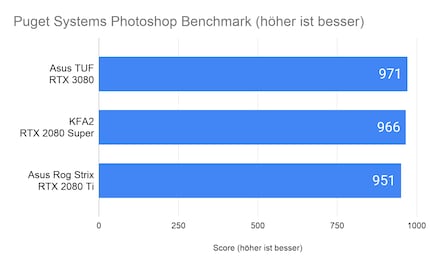
The testbed with the 3080 performs better in the test than the testbed with the 2080 Super and 2080 Ti, but the difference of 20 and 5 points respectively is relatively small. Photoshop performance depends on the GPU, but here clock frequency plays a more important role than the number of Cuda cores. This explains the tight score.
Application: Premiere performance test from Puget Systems
In contrast to the Photoshop performance test, the testbed is not pitted against a reference workstation. In the Puget Systems Premiere test, the score is calculated in relation to the number of frames per second of the test videos. If the test video has a fps of 29.97 and the system displays it at 29.97 fps, that represents 100 points. At 14.98 fps, that's 50 points.
The performance test involves playing back media in 4K H.264 formats at 150 Mbps in 8-bit (59.94 fps), 4K ProRes 422 16-bit (59.94 fps) and 4K RED (59.94 fps). It tests live playback in Adobe Premiere Pro and export. For live playback, the maximum value is 100, as Premiere cannot play the media faster than specified. For export, on the other hand, it is possible to exceed 100 points, as rendering is not limited to the fps of the media.
Here's how the RTX 3080 stacks up against the 2080 Super and 2080 Ti:
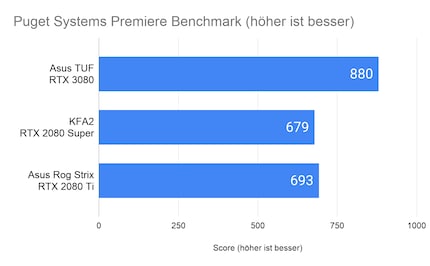
With the Premiere performance test, the difference of 30 and 23% respectively appears greater than in the Photoshop test. This is because Premiere uses the card's Cuda cores and therefore benefits from a much greater performance gain.
Blender
The Blender performance test from bmw27 gives the RTX 3080 the opportunity to display its dominance most clearly. Compared to the Super 2080, performance is effectively doubled. The 3080 is still 60% faster than the 2080 Ti.
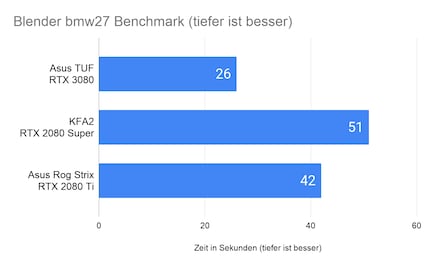
Games
When it comes to gaming, it appears that the RTX 3080 shines most brightly at 2160p resolution, something that many testers have already noticed regarding the Founders Edition. At 1080p, there's very little or no difference compared to the 2080 Ti. The performance improvement with Red Dead Redemption 2 is enormous. If you're wondering why the percentiles aren't shown for the RTX 2080 Ti, I'll tell you that I recorded the fps even differently during the test at the time. Unfortunately, I had to return the 2080 Ti to Asus, so I wasn't able to test again.

The performance improvement with RTX and DLSS enabled is astonishing: Tomb Raider runs about as well as without.
With 1080p resolution, the 3080 has around 20% more FPS than the 2080 Super. This value increases with resolution. At 1440p, this rises to 38% and at 2160p to 58%.
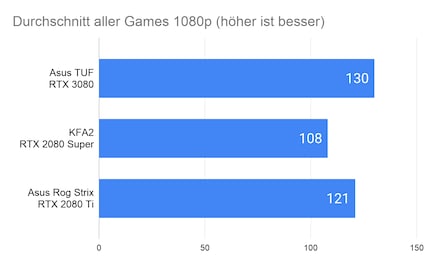
In 1080p, the difference is rather small compared with the 2080 Ti. However, fps is still around 7% higher. With 1440p, this rises to 15% and with 2160p to 30%.
Conclusion: perfect for 2160p
With the RTX 3080, it's finally possible to play games with more than 60 fps at 2160p resolution. The performance boost is huge, and Nvidia wasn't exaggerating when it said Ampere was the biggest generational leap to date. This isn't just true for games: Premiere and Blender are also testament to this huge improvement.
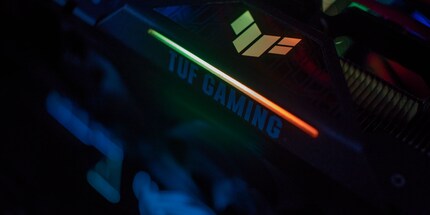
Compared with Turing graphics cards, i.e. the previous generation, the RTX 3080 is a bargain. Such performance for the same price as the RTX 2080 when it came out: that doesn't happen every day.
The RTX 3080 is particularly interesting for gamers who play at 2160p. At lower resolutions, it still offers superior performance, but the gain is less. It's up to you to decide whether it's worth the investment to get 20% more performance than the 2080 Super at 1080p. If so, you'll have to wait until AMD's RTX 3070 and Big Navi come out.
When should you buy an RTX 3080 without waiting? As always, it depends. If you still have a Pascal architecture card, i.e. one from the 10 series or older, and you want to replace your 1080 or 1080 Ti, go ahead. If you have a GTX 1070 or 1070 Ti, you're one of the price-conscious gamers. In that case, I'd wait until the end of October. The RTX 3070 will be arriving along with AMD's new cards. If you have an RTX-20 series card, then I'd wait too. The 2080 Ti will certainly suffice for longer and if you have it, you're probably one of those people who always want the best. The RTX 3090, which is even more powerful than the 3080, will be out next week. If you have a smaller model from the RTX-20 series, I'd also wait for the RTX 3070 and AMD's Big Navi.
The problem in all cases is the availability of the RTX 3080. Depending on the model, you'll have to wait several weeks when ordering from us. So you may have no choice but to wait. Personally, I'll let the next few weeks pass.
From big data to big brother, Cyborgs to Sci-Fi. All aspects of technology and society fascinate me.
